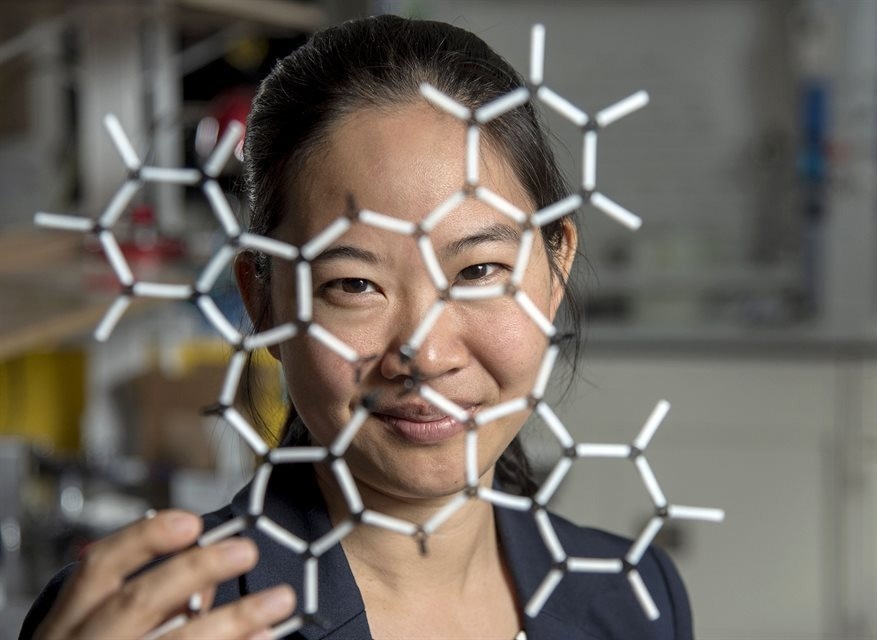Permanent magnets, like those found on refrigerators everywhere, exist because their constituent atoms act as miniature magnets.

Pinshane Huang and her researchers have imaged magnetic behavior at the smallest scales to date. Image Credit: Heather Coit/Grainger Engineering.
These atoms align and integrate to create a larger magnet in a phenomenon known as ferromagnetism. However, few materials exhibit atomic magnets that develop an alternating pattern, resulting in no net magnetization.
These antiferromagnets have garnered attention for their potential to create faster and more compact magnetic memory devices for computing.
To unlock the full potential of antiferromagnetic devices, it is crucial to understand their atom-to-atom magnetic patterns, which have yet to be achieved. However, a team of scientists at the University of Illinois Urbana-Champaign, led by Pinshane Huang, MatSE associate professor and Ivan Racheff Faculty Scholar, has made significant progress towards this goal.
In the journal Ultramicroscopy, the researchers describe a new electron microscopy technique with the potential to resolve magnetic behavior on the scale of angstroms, which is a tenth of a nanometer, almost at the scale of individual atoms. They use this method to fully resolve the antiferromagnetic order in iron arsenide for the first time.
We are working to develop new techniques that can resolve magnetic behavior of individual atoms, and this study is an important step. The best techniques before now have achieved resolutions of a few nanometers. We have vastly exceeded that record.
Pinshane Huang, MatSE Associate Professor, The University of Illinois Urbana-Champaign
Often, microscopic magnetism is quantified with scanning transmission electron microscopy, otherwise called STEM, in which an electron beam has been focused on a material.
The electric interactions happening between the beam and the structure of the material have been notably utilized to offer images of individual atoms in the material, but the beam also interacts with the magnetic structure of the material.
Even though this much weaker interaction is sufficient to identify the longer-range magnetic order discovered in ferromagnets, a far more accurate method is required to note the atom-to-atom variation in antiferromagnets.
In standard, low-resolution STEM experiments, the magnetic interaction can be understood as a small deflection of the electron beam.
Kayla Nguyen, Study Co-Lead Author and MatSE Postdoctoral Research Associate, The University of Illinois Urbana-Champaign
Nguyen added, “On the scale of individual atoms, though, this picture breaks down. The magnetic interactions create complicated and subtle signals in the beam pattern which require new tools to analyze and understand.”
For a higher resolution to be achieved, the scientists switched to a highly powerful method known as four-dimensional STEM. The standard STEM method records a drop in the beam’s intensity as it cooperates with the material.
However, 4D-STEM captures complete two-dimensional scattering patterns as the electron beam scans together the two directions of the surface of the material—for four-dimensional data.
These data enabled the scientists to look for the complete beam patterns for the highly intricate signals of atomic antiferromagnetism.
Simulating the magnetic fields inside the iron arsenide sample was considered to be a crucial step of the analysis, for which the scientists wrote a software package known as Magnstem. MatSE graduate student and co-lead author Jeffrey Huang described that the package enabled them to add magnetic effects particular to their material and also study the effects they had on electron beam patterns.
Nguyen stated, “Magnstem simulations allowed us to compare the electron patterns with magnetic effects turned on versus turned off, something that would be quite difficult to do in a real experiment. We saw that the effects of the magnetic and electric signals occur on different parts of the pattern and can be extracted separately.”
The integration of 4D-STEM with Magnstem simulations helped scientists resolve magnetic order down to 6 angstroms. While this fails to not settle magnetic effects on the scale of individual atoms, it enabled them to resolve the antiferromagnetic pattern of iron arsenide, which duplicates in cells of 12 atoms.
Our work has shown it is possible to resolve small-scale magnetic order in electron microscopy experiments and in simulations, almost at atomic resolution. We are actively developing techniques that will build on this result.
Pinshane Huang, MatSE Associate Professor, The University of Illinois Urbana-Champaign
The scientists worked in partnership with the research groups of Daniel Shoemaker and André Schleife, both MatSE associate professors. Shoemaker’s group produced samples of iron arsenide, and Schleife’s group executed simulations of the magnetic structure of the material.
This study was financially supported by the US Air Force Office of Scientific Research and the Illinois Materials Research Science and Engineering Center, funded through the National Science Foundation.
Nguyen is assisted by a L’Oreal Fellowship for Women in Science. This research utilized electron microscopy facilities in the Materials Research Laboratory at the University of Illinois Urbana-Champaign.
Journal Reference
Nguyen, K. X., et al. (2023) Angstrom-scale imaging of magnetization in antiferromagnetic Fe2As via 4D-STEM. Ultramicroscopy. doi.org/10.1016/j.ultramic.2023.113696.